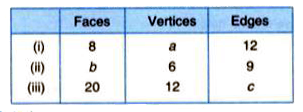Verify Euler’s formula for these solids.
The correct Answer is:Eulers formula
Face + Vertices - Edges = 2
(1)Face=7
Vertices=10
Edges=15
Eulers = F+V−E=7+10−15=2
(2) Face=9
Vertices=9
Edges=16
Eulers = F+V−E=9+9−16=2.
To verify Euler's formula for the given solids, we will follow these steps:
Step 1: Understand Euler's Formula
Euler's formula states that for any convex polyhedron, the relationship between the number of faces (F), vertices (V), and edges (E) is given by:
F+V−E=2
Step 2: Identify the Values for the First Solid
For the first solid, we need to identify the number of faces, vertices, and edges:
- Faces (F) = 7
- Vertices (V) = 10
- Edges (E) = 15
Step 3: Substitute Values into Euler's Formula for the First Solid
Now, we substitute these values into Euler's formula:
F+V−E=7+10−15
Step 4: Calculate the Result for the First Solid
Now we perform the calculation:
7+10=17
17−15=2
Step 5: Verify the Result for the First Solid
Since we have:
F+V−E=2
This confirms that Euler's formula holds true for the first solid.
Step 6: Identify the Values for the Second Solid
Now, we repeat the process for the second solid:
- Faces (F) = 9
- Vertices (V) = 9
- Edges (E) = 16
Step 7: Substitute Values into Euler's Formula for the Second Solid
Substituting these values into Euler's formula:
F+V−E=9+9−16
Step 8: Calculate the Result for the Second Solid
Now we perform the calculation:
9+9=18
18−16=2
Step 9: Verify the Result for the Second Solid
Since we have:
F+V−E=2
This confirms that Euler's formula also holds true for the second solid.
Conclusion
Euler's formula is verified for both solids as follows:
- For the first solid: 7+10−15=2
- For the second solid: 9+9−16=2
Euler's formula states that for any convex polyhedron, the relationship between the number of faces (F), vertices (V), and edges (E) is given by:
F+V−E=2
For the first solid, we need to identify the number of faces, vertices, and edges:
- Faces (F) = 7
- Vertices (V) = 10
- Edges (E) = 15
Now, we substitute these values into Euler's formula:
F+V−E=7+10−15
Now we perform the calculation:
7+10=17
17−15=2
Since we have:
F+V−E=2
This confirms that Euler's formula holds true for the first solid.
Now, we repeat the process for the second solid:
- Faces (F) = 9
- Vertices (V) = 9
- Edges (E) = 16
Substituting these values into Euler's formula:
F+V−E=9+9−16
Now we perform the calculation:
9+9=18
18−16=2
Since we have:
F+V−E=2
This confirms that Euler's formula also holds true for the second solid.
Euler's formula is verified for both solids as follows:
- For the first solid: 7+10−15=2
- For the second solid: 9+9−16=2
Topper's Solved these Questions
Similar Questions
Knowledge Check
What is the Euler’s formula for a Polyhedron?
AF−V−E=0BF+V−E=2CF+V+E=1DF+V+E=3
Complete the following table and verify Euler’s formula in each case.
View SolutionUsing Euler’s formula find the unknown. Faces ?,5,20 , vectices 6,?,12 and Edges 12,9,?
View SolutionA binary solid A+B− has a structure with B− ions constituting the lattice and A+ ions occupying 25% tetrahedral holes. Formula of the solid is
View SolutionA solid is formed and it has three types of atoms X, Y, Z. X forms an FCC lattice with Y atoms occupying one-fourth of tetrahedral voids and Z atoms occupying half of the octahedral voids. The formula of the solid is
View SolutionUsing Euler’s formula find the unknown: Faces, ?, 5, 20 Vertices, 6, ?, 12 Edges, 12, 9, ?
View SolutionUse Euler's formula to find the values of a, b and c.

View SolutionUsing Euler's formula, find the values of x, y and z

View Solution

